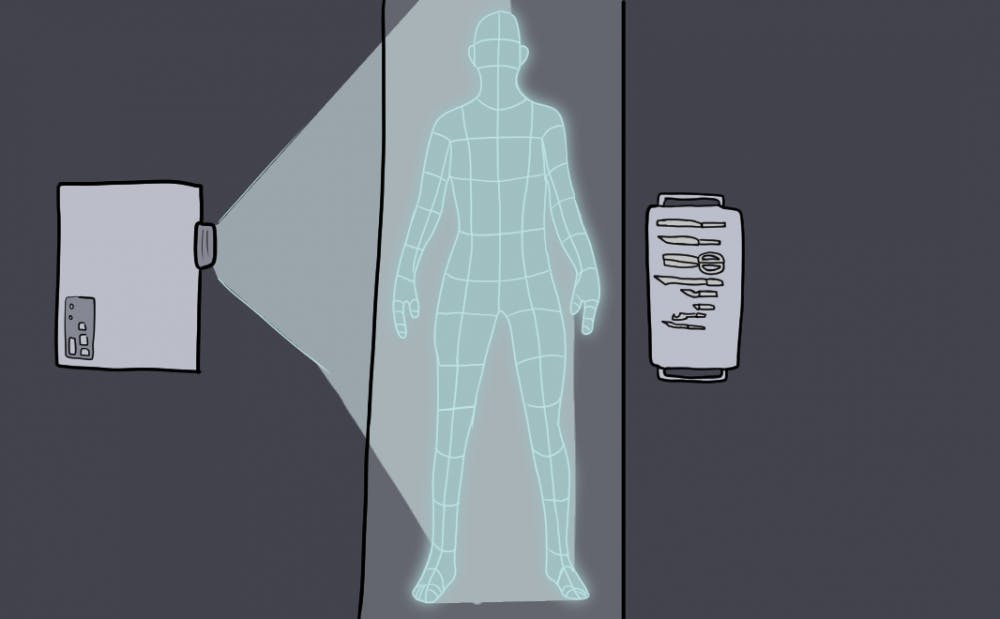Newly purchased technology at the downtown Phoenix campus has reimagined what anatomy classes look like for ASU students.
The Anatomage Table is a digital tool designed to substitute cadavers for students enrolled in BIO 101 and 202. The table is preloaded with software that allows students to "dissect" and explore the inner workings of the human body with precision and detail.
"We pride ourselves on being the most accurate, most detailed 3-D virtual cadaver system," Tommy Le, distribution and marketing manager for Anatomage, said. "Students can repeatedly set the cadavers, learn anatomical structures as well as use our digital library to teach pathology and clinical cases."
The table offers the ability to load in images from MRI and CT scans, allowing physicians or scientists to further examine specific cases. Anatomage models have been featured on shows such as Bones and Grey's Anatomy, as well as a documentary examining King Tut, Le said.
Anatomage offers training for teachers and professors using the software, who then train students on how to maneuver the table with swipes to rotate, minimize or enlarge structures.
"There is a little bit of a learning curve to using the Anatomage Table, but no more so than learning how to use an app or play a particular game," lecturer Tonya Penkrot in the College of Integrative Sciences and Arts said. "We're hoping that with relatively small amounts of training (and a) brief introduction, students have been and will be able to do a lot of the manipulation and exploration on their own."
As enrollment in the entry-level anatomy courses grew, Penkrot said not all students were able to engage with the actual cadavers presented in the classroom.
"There's just no way that we can logistically allow everyone to get the full dissection experience, until now," Penkrot said. "This will give them the ability to explore to a much greater detail (and) explore tissues and structures they haven't been able to really access with something like a plastic model."
Jennifer Legere, a laboratory coordinator at the downtown Phoenix campus, originally proposed purchasing the tool several years ago as an undergraduate student because of the limitations of the equipment being used at the time.
Many students cannot engage with actual cadavers for cultural, social or personal reasons.
"At our campus, we have such a diverse student body that we have students that maybe for religious purposes, or they may have experienced trauma in their life, they can't view cadavers for one reason or another," Legere said. "Having this table gives us a resource especially for those students that would otherwise not be able to view the cadavers."
Legere said that while the Anatomage Table does offer many benefits, it cannot replicate or replace the sensory feeling of working with a physical body.
Penkrot said that plans for a future class that combines BIO 101 and 202 would also likely include using the Anatomage Table, and she could see it being useful throughout ASU.
"Based on our experience with the table thus far, I think this would benefit any program that's teaching human anatomy and physiology," Penkrot said. "I have no doubt that if it's beneficial for students at the downtown campus, it would be just as much so for students at the Tempe campus or any of the other campuses as well."
Penkrot noted that students have expressed overwhelmingly positive sentiments about the new tool and said that the specificity and intricacy the table offers is its single biggest advantage over traditional cadavers or models.
"The students really appreciate not only the detail that the Anatomage Table offers but the ability for students to do some of the exploration on their own (and) see things like individual variations from one person to another (that) you simply can't get from a plastic model that's standardized," Penkrot said.
Reach the reporter at sabine.galvis@asu.edu or follow @sabinegalvis on Twitter.
Like The State Press on Facebook and follow @statepress on Twitter.




